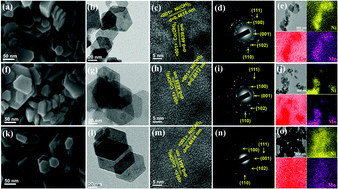Hexagonal plate-like Ni–Co–Mn hydroxide nanostructures to achieve high energy density of hybrid supercapacitors†
Abstract
Nanostructured mixed multi-metal compounds (NCM) based on nickel (Ni), cobalt (Co), and manganese (Mn) are considered as promising electrode materials owing to their multiple valence states, facile accessibility to active sites, and low activation energy for electron transfer. Herein, we demonstrated the fabrication of a hexagonal nanoplate-like architecture of ternary NCM hydroxide with controlled size and composition by a facile one-pot hydrothermal process. The size and composition of the hexagonal NCM nanoplates were controlled by varying the ratio of Ni to (Co + Mn) sources. Accordingly, the maximum capacitance of the optimum NCM is 1188 F g−1 at 1 A g−1 with high rate capacitance due to abundant active sites of the Ni-rich phase and rapid charge transfer kinetics of the nanoplate architecture. By integrating high-capacity Ni-rich NCM hydroxide as a positive electrode with activated carbon as a negative electrode, a full cell of a hybrid supercapacitor (HSC) was configured in the enlarged voltage window of 0–1.5 V. Therefore, the HSC cells deliver the maximum energy and power densities of 42.56 W h kg−1 and 17 791.56 W kg−1, respectively, showing good cycling stability with 78.8% capacity retention over 50 000 cycles and the coulombic efficiency of 100%.



 Please wait while we load your content...
Please wait while we load your content...